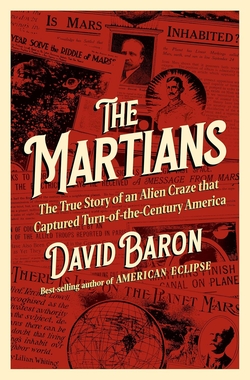Centauri Dreams
Imagining and Planning Interstellar Exploration
Helium Detection at HAT-P-11b
You would think that helium, being the second most common element in the universe, would have been detected in exoplanet atmospheres long ago. A major constituent of the atmosphere at both Jupiter and Saturn, helium seems a natural because planets form from dust and gas from previous stellar generations, but it turns out that the first helium detection on an exoplanet occurred only this year, in a study led by Jessica Spake (University of Exeter).
The planet in question, WASP-107b, yielded its helium signature in data gathered by the Hubble Space Telescope, a detection that showed clear signs of a comet-like tail forming as the planet’s atmosphere escaped. Note the space-based detection: It’s significant because Earth’s atmosphere is opaque to the ultraviolet light the atoms in such an eroding atmosphere absorb.
Could we make this kind of fine-grained study from the surface of the Earth? It turns out there’s a way: Helium in its long-lived metastable state (as compared to its ground state) can be traced in the near-infrared as well as the ultraviolet. If you’re interested in the details on how metastable helium emerges under conditions like these, Kevin Anderton does a nice job explaining things at the atomic level in this Forbes article.
The point is that researchers are beginning to make these detections using ground-based instruments. Thus today’s paper, recounting new work from the University of Geneva (UNIGE), a research effort that includes Spake. The paper’s account of a helium detection from the ground appears in the journal Science for December 6.
The planet in this study is HAT-P-11b, a transiting ‘warm Neptune’ in Cygnus some 124 light years away, where it orbits 20 times closer to its star than the Earth does to the Sun. Central to the work is the Carmenes spectrograph installed on the 4-meter telescope at Calar Alto, Spain, which allowed the researchers to identify helium escaping from an exoplanet whose overheated upper atmosphere is streaming the gas into space in the form of an extended cloud.
Moreover, the instrument’s high spectral resolution allowed the scientists to detect the position and speed of the helium atoms in the atmosphere. According to Spake:
“This is a really exciting discovery, particularly as helium was only detected in exoplanet atmospheres for the first time earlier this year. The observations show helium being blasted away from the planet by radiation from its host star. Hopefully we can use this new study to learn what types of planets have large envelopes of hydrogen and helium, and how long they can hold the gases in their atmospheres.”
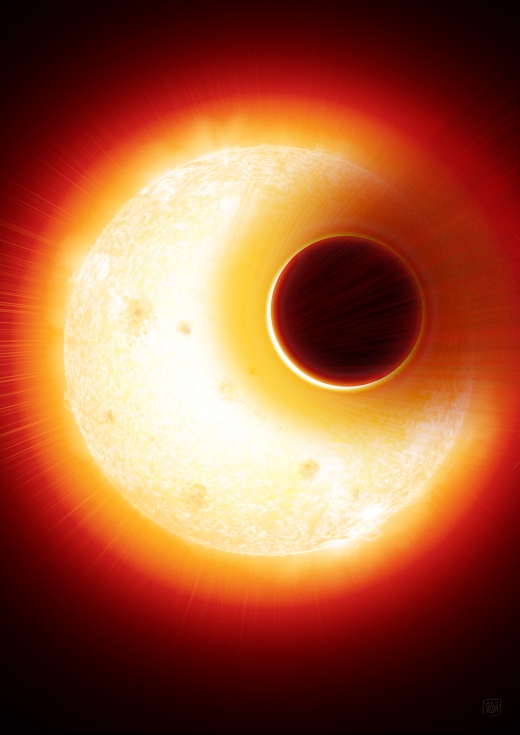
Image: Artist’s impression of the exoplanet HAT-P- 11b with its extended helium atmosphere blown away by the star, an orange dwarf star smaller, but more active, than the Sun. Credit: Denis Bajram.
Vincent Bourrier is a co-author of the study and member of the European project FOUR ACES, an acronym standing for Future of Upper Atmospheric Characterization of Exoplanets with Spectroscopy. Bourrier’s numerical simulations of the movement of the planet’s helium support the spectroscopic observations:
“Helium is blown away from the dayside of the planet to its nightside at over 10,000 km/h,” Bourrier explains. “Because it is such a light gas, it escapes easily from the attraction of the planet and forms an extended cloud all around it.”
First author Romain Allart (UNIGE) adds that proximity to the host star led the team to suspect a high impact on the atmosphere, including the shedding of helium into nearby space. We should expect, in other words, to find numerous other exoplanet atmospheres in this configuration, worlds inflated like a helium balloon. But we’re only now beginning to analyze them. While losing atmosphere is not uncommon in a giant planet close to its star, the predominant element identified in eroding exoplanet atmospheres to this point has been hydrogen.
The Carmenes work makes it clear that ground-based observations can retrieve data on the most extreme atmospheric conditions in exoplanet atmospheres. This is good news for future atmospheric studies, as is the fact that two new high-resolution spectrographs similar to Carmenes are in the works. The Near Infrared Planet Searcher (NIRPS) is undergoing testing at the University of Geneva and will be installed in Chile at the end of 2019. The other, called SPIRou (SpectroPolarimétre Infra-Rouge), is beginning an observational campaign in Hawaii after achieving first light in April. The advent of next-generation extremely large telescopes will further the field yet again by allowing study of escaping atmospheres at smaller planets.
Will we begin to find escaping atmospheres laden with heavier elements? Carbon and oxygen would be slow to escape while hydrogen is the easiest element lost, meaning a giant planet should see a greater amount of helium relative to hydrogen over time. The relative mix we find as we study these escaping atmospheres will help in the analysis of planetary evolution.
The Allart et al. paper is “Spectrally resolved helium absorption from the extended atmosphere of a warm Neptune-mass exoplanet,” Science 6 December 2019 (abstract). The WASP-107b work with the first detection of exoplanet helium is Spake et al., “Helium in the eroding atmosphere of an exoplanet,” Nature 557 (02 May 2018), 68-70 (abstract).

A Quick Riff on New Horizons
We’re starting to get a better view of Ultima Thule, the next destination for the New Horizons spacecraft, which is due to make its flyby of the Kuiper Belt Object also known as 2014 MU69 on New Year’s Eve (0533 UTC January 1) The images below can’t help but recall the gradual approach to Pluto/Charon as New Horizons closed on what turned out to be a spectacularly successful encounter. Here’s hoping Ultima Thule is just as productive in teaching us something about Kuiper Belt Objects in general. Here’s hoping, too, for another KBO flyby down the road.
What we see in the dual images is the view (at the left) through LORRI (Long Range Reconnaissance Imager), averaging 10 individual 30-second exposures, with Ultima Thule just barely visible in the yellow circle. The component exposures were taken about a day before a course correction maneuver on December 2 and show Ultima visible against background stars. At the right is the image re-processed to remove the background starfield. Subtracting the star background has left artifacts in the image which should be disregarded.
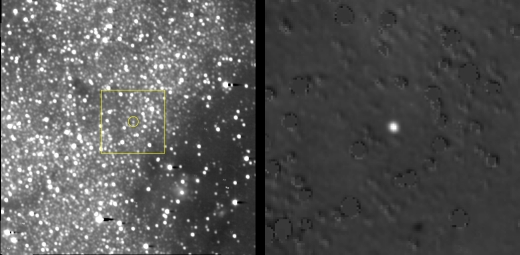
Image: Ultima Thule as seen at 6.47 billion kilometers (4.01 billion miles) from the Sun and 3.87 million kilometers (2.4 million miles) from the New Horizons spacecraft. Credit: NASA/Johns Hopkins University Applied Physics Laboratory/Southwest Research Institute.
Thus New Horizons keeps giving us firsts, this time the furthest trajectory correction ever made enroute to the furthest flyby of any object in the Solar System ever attempted. The inherent ‘kick’ of space exploration is that sense of pushing ever deeper into a realm that has no boundaries. It’s the same sense I had when Huygens was descending on its parachute into the orange haze of Titan, the furthest landfall in human history. One of these days we’ll have landfalls beyond Titan, but for now, flybys are more than proving their worth.
Richard Feynman knew all about ‘kicks.’ On the matter of honors vs. accomplishment (he won the Nobel in 1965), he had this to say:
“I don’t see that it makes any point that someone in the Swedish academy just decides that this work is noble enough to receive a prize — I’ve already gotten the prize. The prize is the pleasure of finding a thing out, the kick in the discovery, the observation that other people use it — those are the real things. The honors are unreal to me. I don’t believe in honors.”
I do believe in honors, but I can agree with Feynman that they’re not what people work for. When someone asked me at a conference what drove me to write about space day after day, it was Feynman I quoted. Why else do we pursue passionate interests but for the ‘kick in the discovery?’ For me, learning new things brings the same exuberance I feel when listening to good jazz — Bill Evans or Miles Davis take me into imaginative flybys of realms that in a way parallel what we do with spacecraft and hard, physical objects. A Dexter Gordon solo opens up a sky’s worth of meditations and you don’t know how it will end.
But back to actual hardware. That trajectory correction New Horizons accomplished on Sunday tweaked the spacecraft’s course to keep it on schedule for arrival at Ultima Thule, a flyby at 3,500 kilometers (2,200 miles) that will take place at 0033 EST (0533 UTC) on Jan. 1. Three other course corrections are built into the game plan if it turns out they are needed. This one, taking place at 0855 EST (1355 UTC) on December 2, was tiny: A 105-second thruster burn that adjusted velocity by a little over 1 meter per second (2.2 miles per hour). We’re 26 days and 17 hours out from Ultima Thule as I write this, with mission elapsed time of 4,702 days.

OSIRIS-REx: Arrival
December 3 goes down as the day when OSIRIS-REx arrived at the asteroid called Bennu. The spacecraft, whose acronym untangles as Origins, Spectral Interpretation, Resource Identification, Security-Regolith Explorer, has been performing braking maneuvers to slow for the approach since October. This has been a long and delicate operation, with arrival marked by a maneuver on Monday to set up the first flyover of the object’s north pole.
Even so, spacecraft and asteroid are flying together while not yet in an orbital relationship. That won’t happen until December 31, when the mission’s navigation team will use the preliminary survey they’re building now to initiate the orbit. Bear in mind that we are dealing with an object less than 500 meters across (about 1,600 feet), so one of Bennu’s distinctions will be that it is to become the smallest object ever orbited by a spacecraft. Now the learning period intensifies.
“During our approach toward Bennu, we have taken observations at much higher resolution than were available from Earth,” said Rich Burns, the project manager of OSIRIS-REx at NASA’s Goddard Space Flight Center in Greenbelt, Maryland. “These observations have revealed an asteroid that is both consistent with our expectations from ground-based measurements and an exceptionally interesting small world. Now we embark on gaining experience flying our spacecraft about such a small body.”
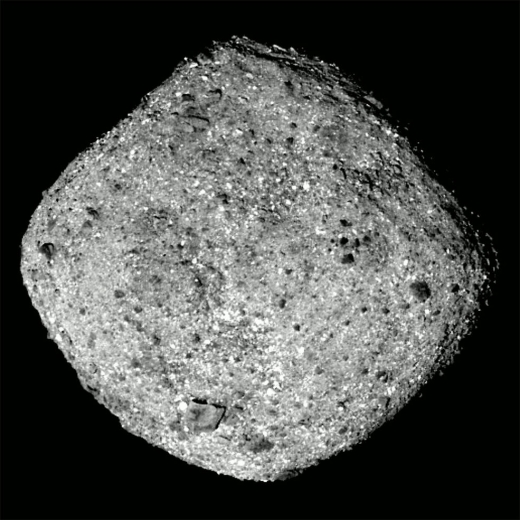
Image: Bennu in an image taken by the OSIRIS-REx spacecraft from a distance of around 80 kilometers (50 miles). Credit: NASA/Goddard/University of Arizona.
As of this morning, OSIRIS-REx is about 19 kilometers (11.8 miles) from Bennu’s surface, with flyovers of the asteroid taking it to within 7 kilometers (4 miles) as the preliminary survey operations intensify. As this is a sample return mission, an early goal is to help identify potential sites for sampling, while tightening up estimates of Bennu’s mass and spin rate. The sampling goal is to collect 60 grams or more of regolith and bring the sample back to Earth in 2023.
So far, another safe arrival, and a satisfying one following the InSight touchdown on Mars. OSIRIS-REx’s initiation of orbital operations at the end of this month coincides with the flyby of Ultima Thule by New Horizons, taking us deep into the Kuiper Belt. We’ll be unpacking and analyzing New Horizons data for months and years while OSIRIS-REx spends the next year mapping its own target (and let’s not forget Hayabusa2, now surveying asteroid 162173 Ryugu, with its own sample return plans). The early reconnaissance of the Solar System continues.
Indeed we have. Thanks to my world-class team for all your hard work to get to this point. Arrival is just the beginning. #WelcomeToBennu https://t.co/4fb6KxgCx0
— NASA's OSIRIS-REx (@OSIRISREx) December 3, 2018

Slowing Star Formation: A Key to Astrobiology?
The rate of star formation in our galaxy is about two new stars per year, a sedate pace that may play its role in the emergence of life. A new study out of Australian National University looks at the factors that can slow star formation, particularly in galaxies and star clusters still young enough to contain large amounts of dusty gas. What ANU’s Roland Crocker and colleagues want to determine is an upper limit on how quickly stars can form in any giant gas cloud.
It’s an issue because conditions inside a tightly bound cluster could be inimical to life. Consider RMC 136, a concentration of stars at the heart of the Tarantula Nebula in the Large Magellanic Cloud. Here we have a cluster with an estimated mass of 450,000 solar masses, with a central concentration about 2 parsecs across. Star formation in this tightly crowded part of the cluster NGC 2070 is intense, but the tight quarters might turn out to be a serious issue.
“If star formation happened rapidly, all stars would be bound together in massive clusters, where the intense radiation and supernova explosions would likely sterilise all the planetary systems, preventing the emergence of life,” says Crocker. “The conditions in these massive star clusters would possibly even prevent planets from forming in the first place.”
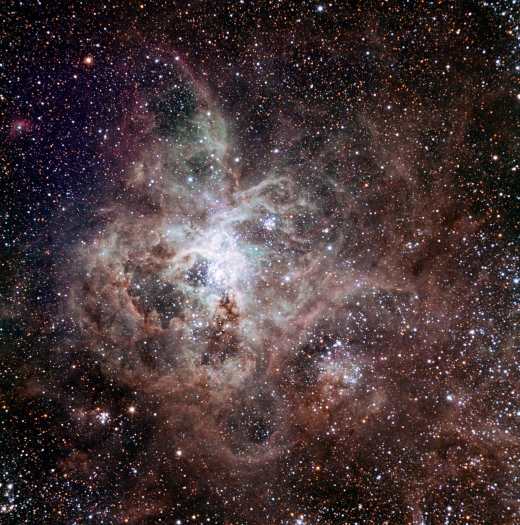
Image: This first light image of the TRAPPIST-South national telescope at La Silla shows the Tarantula Nebula, located in the Large Magellanic Cloud (LMC). This is the most active starburst region known in the Local Group of galaxies. Also known as 30 Doradus or NGC 2070, the nebula owes its name to the arrangement of bright patches that somewhat resembles the legs of a tarantula. Taking the name of one of the biggest spiders on Earth is very fitting in view of the gigantic proportions of this celestial nebula — it measures nearly 1000 light-years across! Its proximity, the favourable inclination of the LMC, and the absence of intervening dust make this nebula one of the best laboratories to help understand the formation of massive stars better. The image was made from data obtained through three filters (B, V and R) and the field of view is about 20 arcminutes across. Credit: TRAPPIST/E. Jehin/ESO.
Dense molecular clouds rich in dust and gas give birth to stars, as clumps collapse through their own gravity and pull in more and more surrounding material, a process that eventually triggers fusion. The ANU team has produced a mechanism for slowing star formation, one that has been studied before but is now mathematically modeled to put limits on the rate of star development.
An important part of the growth of young stars lies in their intense radiation flux, which can drive gas out of nearby space in their cluster. But the paper argues that indirect radiation pressure, which the paper defines as “radiation pressure due to dust-reprocessed photons rather than direct starlight photons,” also plays a role in the dynamics of young clusters.
In other words, dust in the gas from which stars are forming can re-radiate absorbed ultraviolet and optical light at infrared wavelengths. The scattered infrared light acts to slow rather than stop the star-formation process by dissipating nearby star-forming materials. The kinds of effects described here can occur in dense star-forming regions in the Milky Way and other galaxies. What’s new here is the focus on indirect, dust-reprocessed radiation pressure, now factored into the known effects of direct radiation pressure from the stars themselves.
From the paper:
This effect is unlikely to push gas out of clusters in winds, abruptly cutting-off star formation. Rather, systems with sufficiently high initial surface mass densities probably suffer a rather gentle expansion under indirect radiation pressure effects. Only late in their evolution, once they have typically turned well more than 50% of their original gas allocation into stars, will direct radiation pressure effects turn on in such clusters, pushing the remaining gas out of the cluster at greater than the escape speed. This process is complete well before core collapse supernovae start going off in such clusters.
The researchers produce an evolutionary model for dense, protocluster gas-cloud forming stars that tames the potential radiation environment that would emerge in clusters that were too tightly bound. Crocker’s team believes that it takes more than half the material in a molecular cloud to have become stars before direct radiation pressure expels the remaining gas. Calling the combination of indirect and direct radiation pressure a form of ‘feedback,’ the astronomer adds that the twin effects play a clear role in making the conditions for life’s formation possible.
The paper is Crocker et al., “Radiation pressure limits on the star formation efficiency and surface density of compact stellar systems,” Monthly Notices of the Royal Astronomical Society Volume 481, Issue 4 (21 December 2018), pp. 4895-4906 (abstract / preprint).

Super-Earths, Magnetic Fields and Astrobiology
We’d like to know a lot more than we do about how planets create magnetic fields. After all, a major motivation for exoplanet research (though hardly the only one) is to find out whether there is other life in the universe. A magnetic field can protect planetary atmospheres from the effects of the host star’s stellar wind, a stream of charged particles that could disrupt life’s formation. Planets in close orbits of a central star are going to be particularly vulnerable.
But if protecting a planetary surface as well as keeping its atmosphere intact are powerful factors in understanding its evolution, learning more about planetary magnetic fields isn’t going to be easy. Consider a new paper from François Soubiran (École Normale Supérieure, Lyon) and Burkhard Militzer (UC-Berkeley). They’re digging into the question of magnetic fields on super-Earths, in this case planets up to three times the mass of our own world. The scientists believe that magnetic fields could emerge here, but in different ways than on Earth.
The density of some super-Earths, calculated by reference to known radius (from transit studies) and mass (from radial velocity investigations) implies that they are largely made of silicates. While we cannot know with certainty, modeling indicates that their interiors are probably much hotter than Earth’s and reach higher temperatures. The presence of large and persistent magma oceans in their mantles is likely. The question is, could such magma oceans in a state of constant churn generate the dynamo that would produce a magnetic field?
Soubiran and Militzer believe the answer is yes:
“This is a new regime for the generation of planetary magnetic fields,” said Militzer. “Our magnetic field on Earth is generated in the liquid outer iron core. On Jupiter, it arises from the convection of liquid metallic hydrogen. On Uranus and Neptune, it is assumed to be generated in the ice layers. Now we have added molten rocks to this diverse list of field-generating materials.”
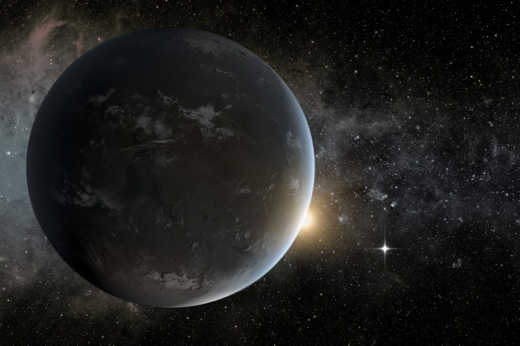
Image: An artist’s concept of a super-Earth in the habitable zone of a star smaller and cooler than the sun. Such large planets could have long-lasting magma oceans that generate magnetic fields capable of protecting incipient life. The graphic was created to model Kepler-62f, one of many exoplanets discovered by NASA’s now inoperable Kepler space telescope. Credit: NASA Ames/JPL-Caltech/Tim Pyle).
On Earth, we locate the processes that generate the magnetic field in the molten-iron outer core, where in combination with the planet’s rotation, churning, electrically conducting liquid iron creates the needed dynamo. But between the core and the Earth’s crust is a mantle of silicates, the silicon-based materials that make up our planet’s interior. The researchers believe layers of material in the mantle of the early Earth may once have produced a convecting magma ocean and a magnetic field, one in place as long as enough material in the mantle remained liquid and convecting.
In the case of super-Earths, the same process could be in play, with the massive scale of these planets keeping their own mantles liquid and convecting for billions of years. The challenge is to test the theory, for working with silicates under conditions like these is, shall we say, problematic. We’re talking about internal planetary temperatures of 10,000 degrees Celsius and pressures up to millions of times greater than atmospheric pressure at the surface.
“At standard temperatures and pressures, silicates are completely insulating; the electrons are either tightly bound to the nuclei or they are in molecular bonds and not able to freely move and create macroscopic electric currents,” Soubiran said. “Even if the high internal pressure helps reduce the barriers for the electrons to move, it was not necessarily obvious silicates would be conducting in super-Earths.”
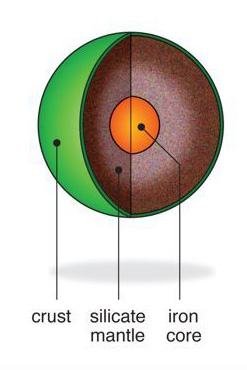
Thus the new paper, which recounts the results from the researchers’ modeling of minerals — quartz (silicon dioxide), magnesia (magnesium oxide) and a silicon-magnesium-oxide (post-perovskite) — at atomic scales, by way of making calculations of their conductivity. We learn that the silicates in question do become conductors as they make the transition to liquids at extremely high pressures and temperatures, enough so as to create a magnetic field.
Image: Layers of a possible super-Earth. The heat of formation of such a large planet could keep its magma oceans active for a billion years, generating its own magnetic field in addition to the magnetic field produced by an iron core. Credit: NASA image.
The rotation of a super-Earth is a factor here. From the paper:
Based on this analysis and with the estimated properties of the silicates mentioned above, to have a dominant dipolar component, one would need to have a rotation period of the planet shorter than 2 days. Such a short period is incompatible with a tidally locked planet in the habitable zone of any star but could be achieved for non-tidally locked planets. Magma oceans on tidally locked Super Earths are thus likely to generate multipolar and not dipolar magnetic fields.
The authors believe that a multipolar magnetic field would be that much more difficult to detect, though the paper does not go into detection methods. And things get more complicated still: While a magnetic field could emerge from a magma ocean alone, interactions difficult to predict are also possible between that ocean and a liquid iron core. What the paper gives us, however, is a calculation of high temperature and pressure conductivity of liquid silicates, showing that with enough convection, they can be conductive enough to support a magnetic field.
The paper is Soubiran & Militzer, “Electrical conductivity and magnetic dynamos in magma oceans of Super-Earths,” Nature Communications 9, Article 3883 (2018). Full text.

Beyond TESS: Looking Toward CHEOPS
As the exoplanet hunt deepens, we’re seeing how research efforts build upon each other, and how the findings of one investigation play into the planning for another. Kepler candidate planets, for example, have been confirmed using ground-based telescopes in radial velocity investigations, giving an independent check that the putative world is really there. TESS (Transiting Exoplanet Survey Satellite) will find planets that refine the target list for the James Webb Space Telescope, with extremely large telescope technology already in the wings.
What we sometimes forget is that this collaborative effort has already built up a healthy momentum. Having maxed out Kepler (and K2 was an outstanding rehabilitation of a damaged spacecraft), the operations of TESS will focus on bright, nearby stars. The momentum of TESS and its contributions to the upcoming JWST should remind us that we then have the European Space Agency’s CHEOPS (CHaracterising ExOPlanet Satellite) mission queuing up for launch.
ESA has just announced 15 October to 14 November of 2019 as the launch window for CHEOPS, whose ancient name bears parallels to NASA’s Lucy mission. Whereas the inspiration for Lucy was a four-million year old ancestor of modern humans who lived in what is now Ethiopia, CHEOPS bears the name of an ancient Egyptian monarch named Khufu — he was known to the Greeks as Cheops — who lived in the Old Kingdom period in the 26th Century BC, and who may well have commissioned the Great Pyramid of Giza.
The link to ancient humanity, whether intentional in the case of the CHEOPS acronym or not, is a fitting perspective enhancer for a mission that involves expanding our understanding of our place in the universe. The purpose of the mission is to provide precise radius information for exoplanets that have been identified by earlier missions like TESS, using a 30 cm optical telescope working in a Sun-synchronous orbit about 800 kilometers above the Earth. CHEOPS will also target exoplanets found by radial velocity methods and larger worlds found in ground-based transit work.
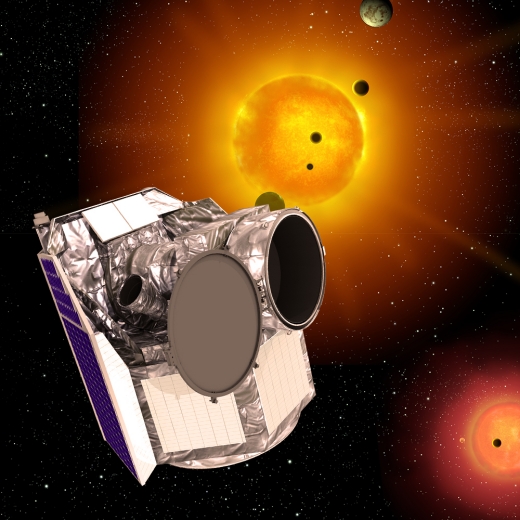
Image: Artist’s impression of CHEOPS. Credit: ESA – C. Carreau
Tightening up our radius estimates of known exoplanets by observing multiple transits of each planet will help to establish the density of these worlds by comparison with mass estimates provided by radial velocity studies. We wind up with constraints on their composition, with the focus on planets ranging from super-Earths to Neptune-class. Out of all this will surely come candidates for follow-up spectroscopic analysis by the instrumentation that will follow.
Having just completed its environmental test campaign at ESA’s technical centre in the Netherlands, CHEOPS is currently at Airbus Defence and Space in Spain for final testing before being declared fit for its 2019 launch. With this in mind, we also look forward to ESA’s PLAnetary Transits and Oscillations of stars (PLATO) mission, whose planned transit work will target one million stars, emphasizing rocky planets in the habitable zone. With launch scheduled for 2026, PLATO is to be followed by ARIEL (Atmospheric Remote-sensing Infrared Exoplanet Large-survey), which will survey the chemistry of roughly 1,000 exoplanet atmospheres.
Those of us whose memories of Apollo are vivid sometimes despair when we see the slow pace of human space exploration in the decades since, but we do see momentum building in the exoplanet realm as developing technologies portend serious breakthroughs ahead. A great age of discovery is upon us even if finding approval for the needed resources isn’t always easy. How the exoplanet revolution unfolds will shape our understanding of our place in the cosmos.

